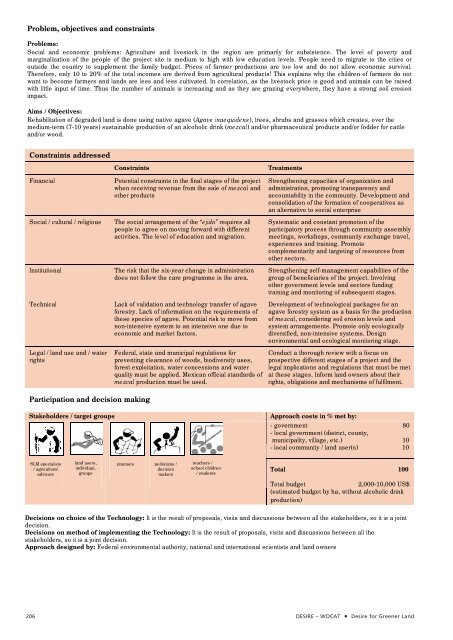Desire for Greener Land
Desire for Greener Land
Desire for Greener Land
You also want an ePaper? Increase the reach of your titles
YUMPU automatically turns print PDFs into web optimized ePapers that Google loves.
Problem, objectives and constraints<br />
Problems:<br />
Social and economic problems: Agriculture and livestock in the region are primarily <strong>for</strong> subsistence. The level of poverty and<br />
marginalization of the people of the project site is medium to high with low education levels. People need to migrate to the cities or<br />
outside the country to supplement the family budget. Prices of farmer productions are too low and do not allow economic survival.<br />
There<strong>for</strong>e, only 10 to 20% of the total incomes are derived from agricultural products! This explains why the children of farmers do not<br />
want to become farmers and lands are less and less cultivated. In correlation, as the livestock price is good and animals can be raised<br />
with little input of time. Thus the number of animals is increasing and as they are grazing everywhere, they have a strong soil erosion<br />
impact.<br />
Aims / Objectives:<br />
Rehabilitation of degraded land is done using native agave (Agave inaequidens), trees, shrubs and grasses which creates, over the<br />
medium-term (7-10 years) sustainable production of an alcoholic drink (mezcal) and/or pharmaceutical products and/or fodder <strong>for</strong> cattle<br />
and/or wood.<br />
Constraints addressed<br />
Constraints Treatments<br />
Financial Potential constraints in the final stages of the project<br />
when receiving revenue from the sale of mezcal and<br />
other products<br />
Social / cultural / religious The social arrangement of the “ejido” requires all<br />
people to agree on moving <strong>for</strong>ward with different<br />
activities. The level of education and migration.<br />
Institutional The risk that the six-year change in administration<br />
does not follow the care programme in the area.<br />
Technical Lack of validation and technology transfer of agave<br />
<strong>for</strong>estry. Lack of in<strong>for</strong>mation on the requirements of<br />
these species of agave. Potential risk to move from<br />
non-intensive system to an intensive one due to<br />
economic and market factors.<br />
Legal / land use and / water<br />
rights<br />
Participation and decision making<br />
Federal, state and municipal regulations <strong>for</strong><br />
preventing clearance of woods, biodiversity uses,<br />
<strong>for</strong>est exploitation, water concessions and water<br />
quality must be applied. Mexican official standards of<br />
mezcal production must be used.<br />
Strengthening capacities of organization and<br />
administration, promoting transparency and<br />
accountability in the community. Development and<br />
consolidation of the <strong>for</strong>mation of cooperatives as<br />
an alternative to social enterprise<br />
Systematic and constant promotion of the<br />
participatory process through community assembly<br />
meetings, workshops, community exchange travel,<br />
experiences and training. Promote<br />
complementarity and targeting of resources from<br />
other sectors.<br />
Strengthening self-management capabilities of the<br />
group of beneficiaries of the project. Involving<br />
other government levels and sectors funding<br />
training and monitoring of subsequent stages.<br />
Development of technological packages <strong>for</strong> an<br />
agave <strong>for</strong>estry system as a basis <strong>for</strong> the production<br />
of mezcal, considering soil erosion levels and<br />
system arrangements. Promote only ecologically<br />
diversified, non-intensive systems. Design<br />
environmental and ecological monitoring stage.<br />
Conduct a thorough review with a focus on<br />
prospective different stages of a project and the<br />
legal implications and regulations that must be met<br />
at these stages. In<strong>for</strong>m land owners about their<br />
rights, obligations and mechanisms of fulfilment.<br />
Stakeholders / target groups Approach costs in % met by:<br />
- government 80<br />
- local government (district, county,<br />
municipality, village, etc.) 10<br />
- local community / land user(s) 10<br />
SLM specialists<br />
/ agricultural<br />
advisors<br />
land users,<br />
individual,<br />
groups<br />
planners<br />
politicians /<br />
decision<br />
makers<br />
teachers /<br />
school children<br />
/ students<br />
Total 100<br />
Total budget 2,000-10,000 US$<br />
(estimated budget by ha, without alcoholic drink<br />
production)<br />
Decisions on choice of the Technology: It is the result of proposals, visits and discussions between all the stakeholders, so it is a joint<br />
decision.<br />
Decisions on method of implementing the Technology: It is the result of proposals, visits and discussions between all the<br />
stakeholders, so it is a joint decision.<br />
Approach designed by: Federal environmental authority, national and international scientists and land owners<br />
206 DESIRE – WOCAT <strong>Desire</strong> <strong>for</strong> <strong>Greener</strong> <strong>Land</strong>









